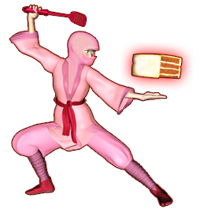Odango: Japanese Mini-Mochi Rice Dumplings
Imagine you’re delivering a sealed, confidential letter from the fortress/castle of the Shogun (the kingpin samurai) in Edo (the ancient name for Tokyo) to the princess living in the Imperial palace in Kyoto. Oh, did I mention you’re on foot? And male. Most of the other travelers are also men and lucky enough to be granted permission to travel the Tokaido Road. If you insist on imagining yourself as a female you’re probably an aristocrat jostled to and fro in a cagey sort of box carried on the shoulders of your servants. (Or more aptly put, your father, husband or brother’s employees.) The distance between the head honcho warrior’s castle in Edo and the palace home to the royals in Kyoto is 367 kilometers or 228 miles.

For photo credits, click here.
Your lunchbox is empty. As is your grumbling stomach. Your throat is parched. There are lodges for the travelers along the Tokaido but you’ve got to keep moving. You’ve got an important letter in your hands. It’ll be your head if it’s not delivered in a timely fashion. So when a red awning alerts you to a roadside café, you pause. A little refreshment and you’ll be energized to stride farther down the Tokaido.

For photo credits, click here.
You wipe your brow. From the limited menu, you order green tea and everyone’s favorite treat - odango. It's a stick skewered with mini-mochi like (pounded rice) balls and typically topped with mitarashi - Japan’s answer to China’s sweet-and-sour sauce. Sometimes, instead of the sauce of soy, sugar and starch, a sweet anko red bean paste is smothered atop the cute little dumplings. Today you are in luck because awaiting you underneath the blanket of red bean paste are odango which are colored pink, white and green to celebrate the sakura (cherry blossom) viewing season. Delighting in the beauty of the sakura, the bitter hot green tea, and the sweet, chewy odango, you are once again energized.

Odango: Mini-Mochi Dumplings
Sweet red bean paste blankets the mini rice dumplings in the picture on the left.
Mitarashi sauce is slathered on the odango in the blue-and-white plate.
With a spring in your step, you forge forward. In a few days, the Shogun’s letter is delivered to the Imperial Princess in Kyoto. You are rewarded great sacks of rice. The letter - as it turns out was a letter of marriage proposal - and the Princess said yes!
Time marches forward. Cherry blossoms die and are reborn. Food fads wax and wane through the centuries. By the 1970s, odango is once again a popular food featured at Japanese festivals. And a sapling Ninja Baker looks forward to her odango with mitarashi sauce.

A tangy-sweet mitarashi sauce atop a trio of Japanese odango treats.
Shortly thereafter, the skewered treat takes a backseat as American fast food is introduced into Japan. Then in 1999 a tongue-in-cheek Japanese tango song entitled Odango 3 Kyodai (3 Brothers Dumpling) dances on to the scene. The single catapults to number one on the charts for three consecutive weeks in a row. Odango once again became a darling of the Japanese public.
Odango 3 Kyodai (3 Brothers Dumpling) skyrocketed to the top of the song charts in 1999. It's very "tangoable" music!
Today you don’t have to wait for the next festival at your local temple. Japanese supermarkets sell odango all over the world. (Including Marukai and Nijiya in Los Angeles.)

The Ninja Baker's Odango-Style Cake Pops
Inspired by my childhood treat, I created strawberry and lemon cake pops à la odango.
Odango Cake Pop Directions:
With your favorite cake recipe or mix, make cake pops in a cake pop maker.
Or by baking a proper cake, cooling it thoroughly. Then crumbling your creation and mushing it together into little balls with frosting. I’ve done both but prefer my cake pop maker.
Freeze your cake pops. After 30 minutes or so, gently stab 3 mini cake balls onto 6” cookie sticks. Freeze some more. I usually go for overnight.

American-Style Strawberry and Lemon Cake Pops
Slather and smooth the cake pops with homemade or canned frosting. Frankly, this is a little more difficult than swirling the frozen cake pops in melted candy chocolate. You can melt the medallions (sold in baking and craft stores) in the microwave. Call me old-fashioned: I prefer the double-boiler method. (Water boils in one pot underneath, as the upper pan or bowl holds the substance being melted.) You’ll want to extinguish the heat - turn the stove flame off - once the chocolate has nearly melted. Chocolate can seize up, so work quickly. If it does harden, add a bit of Crisco or similar substance. (For another - more learned perspective on cake pops - see the article from lovefromthe oven.com.)
Whether you like your odango dumplings made from cake flour or mochiko rice flour, a Japanese friend put it best. “Odango equals fond memories of family travels and fun at festivals.”
Wishing you delicious fun.
The Ninja Baker
© ™ Watkinson 2012
The Ninja Baker's recipes are also available at:
?Allrecipes.com:
The Ninja Baker's Japanese Plum Sweet Memories and Recipes
